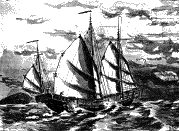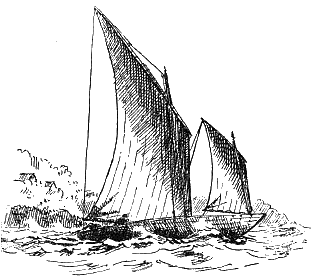 The
shape of hull is unique, and betrays the fact that the
boat is a sailing-boat par excellence, designed for
navigating in rough waters. It is thus in direct contrast
to the canoe form of the Malay craft, which were in the
first place paddling or rowing boats in which sails came
rather as an after-thought. The Rua Pet is essentially a
deep-hulled sailing-boat. Her broad flaring bows rise
high, and are shaped to the overhang form which has been,
in the last ten years, so generally adopted for
racing-craft of all sizes in European waters. The stern
is sharp-pointed; the rudder is shipped on the
stern-post, which curves away down to the keel at a
considerable angle. The bottom of the boat is rockered,
and she is so trimmed that the greatest draught of water
is well abaft the midship section, the boat thus turning
very smartly. Whichever way it is looked at, the hull
presents beautiful curves to the eye; there is not a
straight line about it. The result is just such a form as
the sea loves, and uses kindly in its wildest
moods.
The
shape of hull is unique, and betrays the fact that the
boat is a sailing-boat par excellence, designed for
navigating in rough waters. It is thus in direct contrast
to the canoe form of the Malay craft, which were in the
first place paddling or rowing boats in which sails came
rather as an after-thought. The Rua Pet is essentially a
deep-hulled sailing-boat. Her broad flaring bows rise
high, and are shaped to the overhang form which has been,
in the last ten years, so generally adopted for
racing-craft of all sizes in European waters. The stern
is sharp-pointed; the rudder is shipped on the
stern-post, which curves away down to the keel at a
considerable angle. The bottom of the boat is rockered,
and she is so trimmed that the greatest draught of water
is well abaft the midship section, the boat thus turning
very smartly. Whichever way it is looked at, the hull
presents beautiful curves to the eye; there is not a
straight line about it. The result is just such a form as
the sea loves, and uses kindly in its wildest
moods.
RUA PET, EASTERN SHORES
The buoyancy and sea-worthiness of
these boats is remarkable, and as long as they are kept
with their high bow to the sea they can weather anything.
Aft, especially when loaded, the freeboard is often
rather low.
The best of these boats are generally
built at the various small ports along the eastern side
of the Gulf, such as Bang Pra, Rayawng, etc., and the
wood used in their construction is that of the wonderful
forest tree known to the Siamese as Ton Takien (Burmese:
Thingan), which is found in all the forests of Indo-China
growing to an enormous size, and in worm-defying power is
comparable with teak. It is a heavy wood, and therefore
expensive and difficult to bring out of the forest. Wood
pegs are used throughout the construction, and the
planking is finished flush with the stem and stern posts,
as in the Yorkshire coble, and not rabbeted into
them.
RUA PET, GOING FREE
In common with not a few other Siamese
native craft, the Rua Pet is built with flat stem and
stern posts, having at the gunwale a width of nearly a
foot and tapering downwards to below the water-line. This
method of construction seems to have been a result of
Chinese influences, coming by way of Anam. In many forms
of Chinese sampans, and other small boats, the flat stem
and stern post broadening above the water-line to the
gunwale is common; and in Anam a boat similar apparently
in nearly every particular to the Siamese Rua Pet is
known as gaydiang.
AT SEA
If Anam be the birthplace of this
type, its admirable sea-going qualities will be
explained; for no worse sea can be met with than that
running along that coast in the north-east monsoon; and
the Anamese, who are considered by their neighbours, not
without reason, to be lacking in most good qualities,
must have at least one to their credit.
The boats are ballasted with stones,
over which a flooring is placed for the accommodation of
cargo and crew. A slight decking, which, as is usual
among native craft, is not water-tight, is built across
the boat from the stem to the mainmast. Abaft this, a
coach roof of dried palm-leaves and bamboo laths is built
from gunwale to gunwale to within six or eight feet of
the stern-post. This cover is varnished over and is
perfectly water-tight, and underneath is the hold and
cabin, roomy and comfortable, though ill-ventilated and
hot in a noonday calm.
AT SEA, SOUTH-WEST MONSOON
The space at the stern has a floor or
grating for the helmsman and crew, and under this the
water-jars are usually stowed for the voyage.
A pair of sweeps are carried, and are
used in the ordinary standing-up position common in the
Far East. A couple of anchors, composite wood and iron
grapnels weighted with stones, are stowed forward. When
paid out the cable is nipped in a very clever way by a
small crooked wooden lever, the end of which is pulled
over and held by a rattan grommet slipped over
it.
The sails are made of rectangular
pieces of yellow palm matting, and are very light. They
necessarily have a boom laced along the foot like all
native sails made of this material, and a vang assists to
trim the yard. The sails are always furled aloft along
the yard, by rolling the foot of the sail up on the boom,
and at the same time hauling it out forward. The heel of
the boom is then secured to the foremast, and a line
frapped round the sail keeps all snug. The effect is very
much that of a furled lateen, and is graceful to the
eye.
Reefing is also done by lowering the
yard and rolling up the boom to the required height. The
man doing this uses a short wooden handle thrust through
a grommet in the fore end of the boom as a lever and when
lashed in position to the mast this prevents the sail
unrolling. So even our latest patent roller reefing-gear
is no new thing.
When riding at anchor, in heavy
weather, the main-yard is often lowered on deck; but it
is a huge unwieldy spar and takes nearly the whole length
of the boat. In port, the sail is always smartly unbent,
rolled up in a big ball, and stowed away
below.
The sails are reckoned to last a
twelvemonth, but in their latter days are generally very
ragged and full of holes. The Siamese boatman, however,
does not object to this greatly, as it saves reefing; in
fact, these matted sails are preferred to cotton or duck,
for the very reason that the latter are considered to
press a boat down more, while the mat sail, unlike the
heavier matted sail of the Malays and of many Chinese
junks, provides an automatic relief to the boat in a
fresh wind, by allowing a large proportion of its
strength to pass right through it. At the same time, in
light winds this kind of sail seems to hold the lightest
air.
COAST JUNK, RIVER ME NAM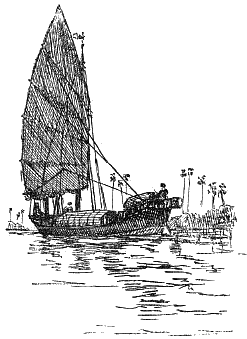
I have watched one of these sails
being bent to the yard and hoisted up, looking through
which one could see the sea and sky on the other side so
distinctly that one felt quite incredulous at its ever
being able to take one safely to a destination between
two and three hundred miles away. Yet we made our
passage, our average run in all conditions of wind and
weather being a hundred miles a day. Our worst experience
was from a sharp 'nor'-wester' at the head of the Gulf;
we kept the whole foresail set, but the mainsail was
reefed until the yard was halfway down from the
sheave-hole. Thus trimmed she carried an easy helm, and
sailed very fast and dry; but the light mat sails could
not stand flat enough in the wind prevailing to enable
the boat to look up very close.
The foresail in these boats is seldom
trimmed or reefed, and is merely a steering sail; as soon
as the wind freshens so much as to increase greatly the
boat's weather helm, the mainsail is reefed.
A SNUG ANCHORAGE, SHELTER BAY
There are no labour-saving devices
whatever, and it takes the whole strength of the crew of
two or three men to swig up the mainyard or get in the
sheet, the boat being necessarily luffed to the wind for
either purpose.
In size these boats vary considerably.
The smaller ones, locally built and used for fishing are
often not more than 20 feet long; but trading boats run
much larger.
The dimensions of a large boat of this
type building at Bang Pra were :--
Length over
all
|
. . . 50
feet.
|
Beam
|
. . . 15 feet.
|
Depth
outside
|
. . . 7 feet 6
inches.
|
She was to cost nineteen catties or
roughly £95, when finished, and her hull would not
require any general overhaul for at least thirty years.
The pegs used in construction were all of hard redwood,
the planking was of 1-1/2 inch thingan, and very
accurately shaped.
When on a propitious day the mainmast
was stepped, and the main rigging, consisting of jungle
rattans, finally set up, the necessary offerings were
made to the various spirits concerned with the boat's
welfare, and she was considered to have commenced
life.
The average size and price of these
boats is somewhat lower than that given above. At
Rayawng, further down the coast, thirty to forty of them
are built and rigged ready to sally out at the end of
each onshore monsoon, to race for the Bangkok and
up-coast market, and their prices range from ten to
fifteen catties (£50 to £80). *1*
The other principal type in the Gulf
of Siam is the Rua Chalom, a name applied to all
sailing-craft of the Gulf without distinction of rig, in
which there are the high stem and stern posts, into which
the planks are rabbeted in the ordinary way. While the
Rua Pet is deep-hulled and two-masted, and is always the
boat of the Siamese, the Rua Chalom is a long, shallow
draught vessel, and is more favoured by the
Chinese
*1* They run up to 6 wa (39 feet 6 inches) in length,
with 6 sawk kub (18 feet 8 inches) beam, and a draught of
3 feet 4 inches to over 5 feet when loaded, the outside
depth being 6 feet to 7 feet.
COASTER IN A SQUALL
•••
SEA-GOING RUA PLA
and Luk-Chin *1* fishing population of
the coast. The smaller boats of this type are used
entirely for fishing purposes. They row well, the crew
always standing up on the gratings to the work, and
pushing the oar before them.
*1* The name given to the children of mixed
marriages between Chinese immigrants and Siamese
women.
Under sail they carry one large
standing lugsail, which is reefed in the same manner as
that already described, but is seldom furled aloft except
in the bigger and deeper boats. As in the Rua Pet, there
is no purchase to halyard or sheet, and it often takes
every bit of five men to set the great
mainsail.
RIDING IT OUT
A peculiarity of these boats is the
steering gear, which consists of two rudders, slung at
the upper end on stout uprights at the quarters, and held
in just above the blade by a stout piece of rattan. The
lee rudder is that generally used under sail, both
because of its deeper immersion, and the greater power it
gives to counteract the boat's weather helm. In running
before a heavy sea both are used, and when lying at their
fishing-stakes it is not unusual to see one unshipped and
set up aft to act as a mizen to keep the boat's head to
sea. In port they are slung up at the quarters, and, flat
side uppermost, they are useful for fish cleaning or
cutting bait, or for eating the morning rice off. This
method of slinging and using quarter rudders is the
oldest used by men in sailing-craft, and is the first
development from the simple paddle rudder which has in
all ages been the first method of steering
boats.
The simple paddle or steering oar may
be seen in every stage in Siam. The king's state barge is
steered by two men with long steering paddles in
precisely the same way as was done in the case of the
Egyptian boats of the Third Dynasty, 6300 years before
Christ. *1*
RUA CHALOM
The long, fixed steering oar of the
up-river cargo carrier of the Lao country is used on the
same principle as that of the more developed steering
paddle in the Egyptian ships of the Punt Expedition, 1600
B.C., *2* which simply turned on its own axis. The slung
quarter-rudders of the Rua Chalom are the same as those
used in all the Ottoman and Greek merchantmen
*1* Villiers Stuart's Nile Gleanings
*2* Holmes's Ancient and Modern Ships, and
Torr's Ancient Ships, and other works.
and galleys from 500 B.C. downwards,
by the Norsemen and Anglo-Saxons a thousand years after
Christ, and by mediaeval seamen down, at all events, to
the fourteenth century, when the rudder appears to have
been first slung on the stern-post, both in the North and
in the Mediterranean. *1* It became general in Europe
after that date, but prevailed still in the Far East for
boats with high stern-posts and shallow under-water body
aft, such as the Rua Chalom, for which it was peculiarly
fitted.
QUARTER RUDDERS:
EGYPT • SIAM
NORSE • ROME
The smaller Rua Chaloms are manned by
three, or preferably four, men. These are exquisite
little craft, and to see them carrying on for the Bangkok
market in a strong breeze is a goodly sight.
While they handle the boats very
smartly under sail, the tall, dark-burned crews are seen
to even finer advantage on a hot airless morning, when
standing to their great long oars they force their boats
with the whole weight of their glistening bodies through
the calm, streaked water. At such times, beating the
water in long, powerful strokes together, about eighteen
to the minute, bending their bodies until almost
horizontal at the finish, and springing smartly to an
upright position again poised on the back-placed leg,
they maintain a speed of six knots or more for a couple
of hours without a spell.
The larger sea-going fishing-boats are
between 40 and 50 feet long, and at the waist often have
an additional strake or two built up for about two-thirds
of their length, to keep the water out when heeling, the
freeboard when loaded up being rather insufficient at
this point. The contrivance reminds one of the canvas
screen fitted along the waist of the low-sided Greek
boats of the Aegean.
*1* The Poole seal of 1325 first shows this method
of slinging the rudder, and Charnock figures a Venetian
galley of this century with a similar rudder.
They carry a crew of seven men, and
are engaged principally in the Pla-tu fishery, which
takes place on the east and west coast of the Gulf in
turn, as each shore gives shelter to the fish from the
prevailing monsoon. Elaborate fishing-traps are built
each season at great cost and trouble, as soon as the
onshore winds begin to give way to the offshore monsoon.
Converging lines of stakes half a mile long worked into
the mud and sand of the bottom, lead to the central trap,
a large strongly built enclosure of interwoven stakes. So
solidly are these built that sailing at night
necessitates a very sharp look-out, when in shallow
soundings, among them, as collision will mean loss of a
bowsprit at least, if nothing worse.
A good deal of seining is also done by
these boats, one or two of the smaller three-men boats
being in attendance. The results of the catch are dumped
into big tubs or pits, where in the course of a few
months they mature into that popular delicacy called
'bala-chong' or 'kapi,' dear to the heart of every
properly educated native of the Indo-Chinese peninsula.
It has other uses besides tickling the palate of the
epicure, and stimulating the olfactory nerves of the
European traveller; for it is said that the number of
depots along the Coast have saved the Siamese Government
large sums annually which would otherwise have had to be
expended on lighthouses, the odour even on foggy nights
carrying further than the brightest light, and warning
the mariner off the coast far more
effectually.
One peculiarity of these boats remains
to be noted. Their rounded shallow form of hull makes
them sail well over the wide mud expanses exposed along
some portions of the Gulf at low water. Coming in with a
fair wind, each boat takes its own well-worn track
leading to the long fishing stages built out from the
land, and with a man or two out over the stern on their
broad wooden mud-skates to steer, they sail gaily in to
their mooring, half a mile or more as may be
necessary.
The largest form of Rua Chalom used
for trading is two-masted, and a much deeper vessel than
the fishing-boats. Sometimes the double rudders also are
discarded, and a single rudder is shipped in the ordinary
way upon the stern-post. The boats then become much more
allied to the small Chinese two-masted trading junk, and
often have the China sail instead of the Siamese form of
sharp-peaked lugsail.
RUA CHALOM CLOSE-HAULED
The strong coach-roof abaft the
mainmast is retained, and, in addition, the helmsman is
often accommodated with a peculiar little shelter right
aft, the floor of which is built out considerably on the
after-side. This is the embryo of the more commodious
stern galleries of the true junk.
One other peculiar craft is met with
on the Gulf, called simply Rua Ta, from its enormous
cod-like eye. It is apparently Cambodian in origin, and
comes from various small ports down the east side. It
cannot claim to be very graceful, and is a lumbering
hull, with grotesquely painted fore and stern galleries.
It generally is rigged with the form of lug common in the
Gulf, only with less peak, and has a mizen. But the China
lug is adopted in some instances, with advantage in the
set but the disadvantage of greater weight aloft. They
run up to 60 feet in length and have large carrying
capacity, but are neither fast nor weatherly, nor as
taking to the eye as the other craft of the Gulf, or the
true junks of Southern China.
CAMBODIAN AT SEA
Just as on the mainland of Indo-China
the Chinese have played a very prominent part for
centuries, so on all the seas that wash the coast of the
great peninsula their ships and their seamen have
maintained regular navigation. The junk rig, described
elsewhere, is as common as any other in the Gulf of Siam,
although the great increase in steam tonnage has given
the deathblow to the great junk trade of thirty years
ago; and the five-masters, like the square-rigged ships
which used to be seen beating out in crowds over the Me
Yam bar in the old days, have now almost
disappeared.
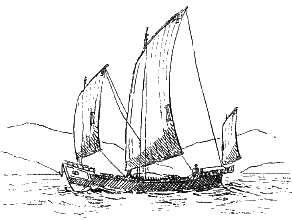 CAMBODIAN
COASTER
CAMBODIAN
COASTER
Besides the large three-masted junks
of several hundred tons, which still come round in
considerable numbers from southern ports in the China Sea
in the north-east, and return with the south-west
monsoon, many small junks survive, and indeed show no
sign of disappearing from the Gulf. They are nice, handy
little craft, from 30 to 50 feet long, generally
two-masted, and manned by what is for Chinese a small
crew of four or five men. They are genial, pleasant
fellows to sail in company with, these Chinese sea-coast
settlers, and are full of fun and good humour. Beating
down under the lee of the Malay Peninsula, in the
south-west monsoon, in company with half a dozen of these
little traders, one may have opportunities of seeing some
very fine seamanship exhibited by these men in the
terrific squalls which break at that season. At night,
cross-tacking with these boats is rendered picturesque by
the flares which they light each time they go about, to
appease the devils of the sea. In my own boat, a
thirty-six footer, while engaged on duty in this
locality, I have followed these boats in the dark,
warping against the current into the river harbours along
the coast.
A COAST TRADER - EAST SHORES
They have the aid of three or four
crews from neighbouring boats, and their illuminations on
the poop, their splashing oars and quants, and the
pandemonium of yelling, chorus-singing, and gong beating,
awake the whole jungle neighbourhood for miles; though,
as our exhausted crew found to their cost, it all seems
to do but little towards appeasing that devil of a
current. The absence during part of each month of one of
the two usual semi-diurnal tides, a phenomenon also
observable in the Gulf of Tonkin, makes getting in and
out of these badly marked and ever-shifting channels a
matter often of danger and always of difficulty. For the
live tide, like the owl, invariably chooses the
night-time for its walks abroad, being apparently shy of
observation.
LORCHA RUNNING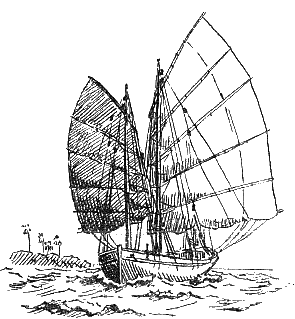
Reference must be made also to a very
distinctive craft used in Bangkok, the Lorcha, or sailing
lighter. These craft run to two hundred or more tons, and
are used to carry rice out over the bar of the river to
ocean ships completing loading in the roadsteads at Kaw
Si Chang or Anghin. The hull is built in Bangkok, of the
good teak wood of the country, on European lines; but the
rig is that of the usual Chinese three-master, for
facility of management by their Chinese crews. They are
fine, powerful vessels, and some sixty or more are owned
in Bangkok by the various more important exporting firms.
Canvas was introduced for the sails by my old friend the
late Captain Hicks, in place of the red-brown matting,
but it is doubtful if its greater durability is
sufficient to make it cheaper in the long-run. The
matting sails only last a year, and sometimes get so full
of big holes as to be dangerously near carrying away
completely in a hard blow after eleven months' wear; but
they are certainly more picturesque and, it is said,
lighter for handling.
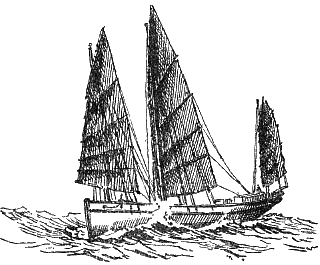 LORCHA
CLOSE-HAULED
LORCHA
CLOSE-HAULED
On one occasion, when going on duty
for the Siamese Government, I sailed a boat thus rigged,
but without the mizen, from Bangkok to Singora in the
Malay Peninsula and back, a distance of some twelve
hundred miles. She was an old teak steam launch built for
the Me Yam river, and was about 36 feet long over all,
but leaky, and narrow and crank for her size. I had a
young Siamese officer, my assistant Surveyor, with whom I
had been many journeys, who shared the cabin with me, and
the crew consisted of my Siamese servant and boat-boys.
Every Siamese is used to a boat, but only two of them had
been to sea with me before. They turned out splendid
sailors, and endured the discomfort of a beat of six
hundred miles against the monsoon with that cheerfulness
which is characteristic of the Eastern, and makes him the
best fellow-traveller in the world.
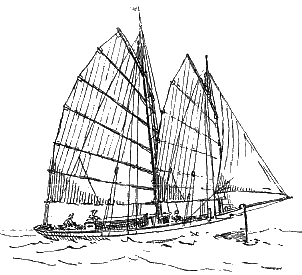 SIX
HUNDRED MILES AGAINST THE MONSOON--ALL SAIL
SIX
HUNDRED MILES AGAINST THE MONSOON--ALL SAIL
We put the handiness of the Chinese
lugsail to a very practical test in the squally weather
of the rainy season. The monsoon wind is ever varying in
force and direction in the Gulf of Siam, broken as it is
in its passage from the Indian Ocean across the high
ranges of the Peninsula. At night a very sharp watch had
to be kept for squalls, and simplicity and quickness in
reefing and 'making' sail proved to be of the utmost
value. Unless the night was unusually fine we never
carried the jib, a rare sail in these waters and our
special pride, but had one batten of the mainsail down in
the topping lifts, and whole foresail.
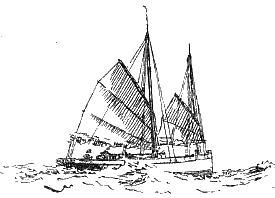 REEFED
REEFED
The boat was then quite easy for one
hand to manage, and as we were all suffering from
malarial fever, it was important not to have more than
were absolutely necessary in the deck-watch. Black
squalls would threaten and batter us, or would pass away
to leeward some miles ahead or astern, always, however,
increasing the wind and the sea. When one of these was
approaching, all that had to be done was to take a turn
of the tiller rope, go forward to the main halyard, and
lower away until so many battens were lying snugly in the
topping lifts; then similarly with the foresail. Both the
sheets would need shortening in a bit, and the thing was
done. The watch could return to the cockpit, take a cast
of the lead and a look at the chart, wrap up in his
oilskins again, take a last look round through the
night-glasses, then bow his head to the stinging,
blinding onslaught.
As an instance of the kind of weather
experienced, I give an extract from the log, the day
after we started back from Singora, when I had finished
my duties :--
August 21-8 A.M.
- Westerly gale all day. Posted letters. Getting
ready for sea; awnings and boat-boom in; running
rigging rove; Berthon dinghy and gear stowed;
unmoored ship, etc.
4 P.M. - Got under way. Squalls
off the hill, very strong; set three-reef main and
two-reef fores'ls, and reached up the harbour to
clear fishing-stakes; turned and went bowling out;
awkward back-squalls under the Head. Cleared stakes
and went out down the channel. Wind outside N.W. 4,
and a short tumble of sea breaking; flood making up
against it. Very dirty-looking to
windward.
6 P.M. - Tacked inshore and kept
her going easy till supper cooked (rice and salt
fish curry, rice and sugar pudding, and tea). Wind
went to W.N.W. 3; set all sail along the coast on
port tack against head sea; this and head winds
seem to be our fortune.
Midnight. - Turned out, called
by Yen. Very dark to Nor'ard spreading out our way.
Wind N.W. 3. Took in jib; tacked ship, four-reefed
main and foresail. Sent boys below. Came on to blow
heavy with tremendous rain for 1.5 hours. By which
time fairly under lee of the land. Everything
soaked. Very cold.
August 22-1.30 A.M. - Wind W.
Tacked ship and shook out two reefs in both
sails.
4 A. M. - Moon setting; very
dark but fine, and water smoother. Shook out whole
foresail.
6 A.M. - Turned out the rest.
Wind W. 2-3 ; set whole sail, and got breakfast as
soon as possible. A Malay penjajap astern, and a
big Malay (with China sails) outside. Dull-grey
cloudy sky, but finer-looking. Only damage last
night was breakage of big thermometer. As we tacked
in, lots of seining parties along the shore, with
their long canoes, shouting and hauling; small
temporary fishing cottages under the Casuarinas; at
the back, low jungle.
9 A.M. - Aneroid 30.09; wind W.
by 2, sunshine. Singora hill still just visible
astern.
10 A.M. -Freshening. W. 3-4,
going grandly.
11 A.M. - Took in foresail,
passing big villages. Clouding up and
rainy-looking.
Noon. - Aneroid 30.02;
thermometer 80F off Tung Ranawt, thirty miles from
Singora Island. Freshening. Took in jib; set
three-reef fores'l and four-reefed mainsail. Wind
hauling N.W. 6.
1.30 P.M. - Close-reefed
Plunging into it, blowing hard, squalls to
south'ard.
2.30 P.M. - Shook out two reefs.
Wind W. 5.
3.30 P.M. - Took down two reefs
again. Wind W. 6, squalls to Nor'ard. Going fairly
dry.
4 P. M. - Close-reefed: blowing
harder than ever, W.N.W.
5 P.M. - -Shook out two reefs,
Wind W. 5, dull blank wall of blue cloud over
Lakawn mountains, showing their 6000 feet peaks far
to the north-west. Everything same cold steel-blue
colour.
6 P.M. - Got supper, and very
glad of it, as all very chilled.
6.30 P.M. - Had all sail on her.
Weather finer.
We reached Lakawn Roads next morning,
meeting only one heavy squall during the night, which
lasted some hours.
On only one occasion, in the upper
part of the Gulf, were we reduced to less than four
reefs. A very bad squall struck us before sunset, and
although all sail was off her, and we had only the bare
masts and the bunched-up sails lying in the topping lifts
to hold the wind. We were nearly on our beam ends for an
hour. We all but lost the Berthon stowed on deck; but
were able by degrees to hoist up one batten of the
mainsail to keep her head to sea. During the rest of the
night we beat to windward under four reefs.
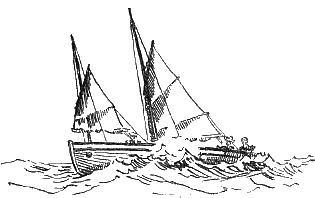
SHIP'S LIFEBOAT, CHINA LUGS, REEFED
With a raw crew such as we had no
other sail could have possibly been so easily handled on
all these occasions as the China lugsail, and for those
seas there is nothing, in my opinion, to equal
it.
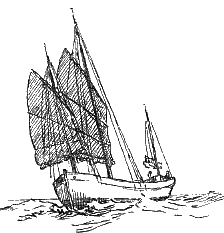
LORCHA, SOUTH-WEST MONSOON
Another experience when on a pleasure
cruise in a 40-ton lorcha on the eastern side of the Gulf
was equally favourable to the China lug. It was also
during the south-west monsoon from which we had sought
shelter for the night among the islands inside Cape
Liant. As the weather did not moderate, and a heavy sea
and strong wind continued next morning to drive in on the
coast, it came to beating out off the lee shore through a
very threatening line of breakers which thundered along
the edge of the four-fathom line.
The crew consisted of two Malays
and my faithful Siamese 'boys.' We hoisted every inch of
sail that we dared show, as it was a case of pressing
her, and a single miss stays was going to be a serious
thing. But nothing could have been more manful than the
way that little ship swung up to the breakers, the mizen
well in bringing her head to wind, and the foresail
paying her head off on the fresh tack. Once she gathered
rapid sternway, helped by the steep breaking sea, which
was roaring over black rocks not fifty fathoms to
leeward. Every one stood silent on deck at his station,
watching. Only an exclamation from Yen, the coxswain, as
a sea toppled over forward and carried him off his feet,
caused a general laugh for a single moment.
LORCHA, ON A LEE SHORE
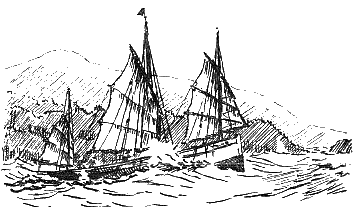 It
was the last ledge we had to clear. We slowly gathered
way and were soon in the long regular sea outside, then
lowering another batten in the mainsail, we could breathe
again. The customary chatter of the Siamese was speedily
renewed with not a few jests at the expense of the
mermaids known to inhabit the locality, and speculation
as to their feelings at seeing us fetch out in
safety.
It
was the last ledge we had to clear. We slowly gathered
way and were soon in the long regular sea outside, then
lowering another batten in the mainsail, we could breathe
again. The customary chatter of the Siamese was speedily
renewed with not a few jests at the expense of the
mermaids known to inhabit the locality, and speculation
as to their feelings at seeing us fetch out in
safety.
It is impossible to leave the craft of
the Gulf of Siam without a word about the hardy, cheery
fellows who build and man them. Whether it was the
gentlemanly, pure-blooded Siamese crew of a Rua Pet, or
the rough Luk Chins or Chinamen sailing the Rua Chaloms,
they were the same; in all weathers and under all
conditions cheerful, willing, and astonishingly
friendly.
ANCIENT BOAT, LIKE SIAMESE SAMPAN
(GIZEH MUSEUM)
In their language, their ways. and the
nameless something which is bred in seamen, they are
quite distinct from the shore-going population; and their
smartness and pluck in handling their little vessels
makes them a seafaring class of which any coast might be
proud. They eat little, and know few luxuries; clad often
in nothing but a pair of short, loose, white and blue
trousers coming halfway down the thigh, they face rain
and sun, cold and tropic calm. Their hard brown skins
glisten like oilskin coats, and seem as hard and
impervious to weather. Finer built men it is impossible
to meet. and with a handkerchief round their thick black
hair, and a coloured scarf thrown across their great
brown shoulders, they make fine figures of men. And
beneath a weather-beaten, and even an uncouth, exterior
there lies an honest, gentle heart that finds expression
in a quiet voice and ready smile.
BANGKOK SAMPAN
GOING NORTH, LIGHT
I had a fairly long and varied
experience, and have lived at close quarters with these
men within the narrow confines of a 35-footer, and at the
end can only say that they have a large share of that
direct simplicity of mind and heart which is in the gift
of the sea. Remarkable as is the seafaring nature for
kindliness of heart and contentment of mind, these
characteristics are nowhere more pronounced than in the
sea-going classes of the Gulf.
Religion and climate, and temperament
resulting from these, have gone far to make the Burmese
and Shan, the Siamese and Malay, the excellent comrades
that they are to any man whom fortune may lead into their
jungle tracks. But if the thoughts of the jungle man are
worth exploring, and the sights of his surroundings are
worth seeing, those of his brother sailing the
monsoon-whipped seas of the tropics have always seemed
more so.
ME NAM RICE-BOAT,
COMING SOUTH
For into his life has entered not only
the voice of the jungle, which admits all the sons of
Nature to secrets that lighted cities cannot do, but to
him has called that deep song of the sea which adds a
peculiar temper to the most unpromising material, and
turns the true stuff into glowing metal. With a certain
wistfulness which is alike in young children and in
sailormen, there is especially among these people a
patient contentedness of mind which, if it will never go
far to build up a rigorous people in the Western sense,
yet holds a very real charm, and has surely a merit of
its own in contrast to the feverish unrest of much of
Western society.
ON THE ME NAM
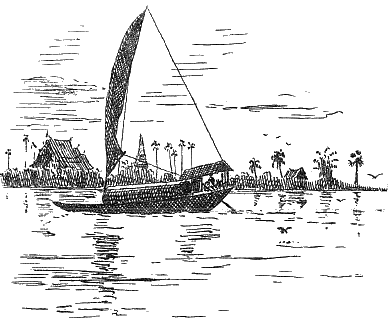
If the divine discontent which is the
heritage of the British race is one of the sources of its
power, there are yet many aspects of it, which are to be
met too frequently in society, which certainly appear to
hold but little of good for the future of any race, and
which cannot but compare curiously with the state of mind
which one has left dwelling by those long stretches of
palm-fringed shore, with the deep jungle sounds behind
and the blue, wind-flecked waters before-shimmering
sleepily in the noonday sun, or roaring with their many
voices in the thunderous night-squalls.
I have said nothing about the river
craft of Siam, for, like most river boats, they only use
the sail as an auxiliary in fair winds. But of their kind
they are the handiest, best-finished vessels to be
anywhere met with for inland navigation.
AN UP-COUNTRY FAMILY HOME, SIAM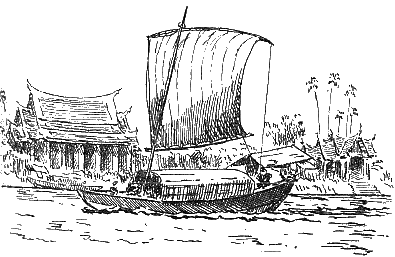
They are almost invariably teak-built,
or with teak topsides over a thingan keel and
bilge-piece. The beautiful teak colour is preserved and
heightened by several coats of chunam or dammar oil.
Complete coach-roofing of beautifully worked reed matting
keeps off the fierceness of the sun and the torrential
rains. The fore-deck is open for the use of the crew when
working the sweeps or quants, and on the lofty platform
of the high stern the steersman stands, steering with his
toe while he greatly helps his boat forward with a long
oar slung in the usual grommet on a stout crutch at the
gunwale.
The Rua Pet is the usual Siamese type
while the larger Rua Chao or rice-boat is of Chinese
build.
The Rua Nua, as its name implies, is
the boat of the Lao country northward and is seldom
sailed. The peculiar long-nosed and long-tailed variety
is the boat of the west or Chiengmai River, while a
snub-nosed, short-sterned type of larger burden is used
in the Eastern main river.
CAMBODIAN LAKE-BOAT
Not infrequently in the big rice-boats
the rudder is slung on the quarter, as in the Rua Chalom
and ships of the ancients, a pair of them being often
used one upon each quarter *1*
A tall bamboo mast setting a
high-peaked cotton lugsail laced to a boom at its foot is
the usual inland sail, and is fitted alike to the
rice-boat of 12 feet beam and the tiny dug-out of the
monastery novice scarcely 10 inches in width.
And these craft, of infinite variety
of shape and finish, are the homes of a population
numbering in all probability several hundred thousand who
spend their lives on board navigating the intricate and
beautiful waterways of what to them is more truly than to
most the Land of the Free.
*1* For a further description of these river
boats and the life of their people, the reader may be
referred to the author's Five Years in
Siam.
 The
shape of hull is unique, and betrays the fact that the
boat is a sailing-boat par excellence, designed for
navigating in rough waters. It is thus in direct contrast
to the canoe form of the Malay craft, which were in the
first place paddling or rowing boats in which sails came
rather as an after-thought. The Rua Pet is essentially a
deep-hulled sailing-boat. Her broad flaring bows rise
high, and are shaped to the overhang form which has been,
in the last ten years, so generally adopted for
racing-craft of all sizes in European waters. The stern
is sharp-pointed; the rudder is shipped on the
stern-post, which curves away down to the keel at a
considerable angle. The bottom of the boat is rockered,
and she is so trimmed that the greatest draught of water
is well abaft the midship section, the boat thus turning
very smartly. Whichever way it is looked at, the hull
presents beautiful curves to the eye; there is not a
straight line about it. The result is just such a form as
the sea loves, and uses kindly in its wildest
moods.
The
shape of hull is unique, and betrays the fact that the
boat is a sailing-boat par excellence, designed for
navigating in rough waters. It is thus in direct contrast
to the canoe form of the Malay craft, which were in the
first place paddling or rowing boats in which sails came
rather as an after-thought. The Rua Pet is essentially a
deep-hulled sailing-boat. Her broad flaring bows rise
high, and are shaped to the overhang form which has been,
in the last ten years, so generally adopted for
racing-craft of all sizes in European waters. The stern
is sharp-pointed; the rudder is shipped on the
stern-post, which curves away down to the keel at a
considerable angle. The bottom of the boat is rockered,
and she is so trimmed that the greatest draught of water
is well abaft the midship section, the boat thus turning
very smartly. Whichever way it is looked at, the hull
presents beautiful curves to the eye; there is not a
straight line about it. The result is just such a form as
the sea loves, and uses kindly in its wildest
moods.

 CAMBODIAN
COASTER
CAMBODIAN
COASTER

 LORCHA
CLOSE-HAULED
LORCHA
CLOSE-HAULED
 SIX
HUNDRED MILES AGAINST THE MONSOON--ALL SAIL
SIX
HUNDRED MILES AGAINST THE MONSOON--ALL SAIL
 REEFED
REEFED


 It
was the last ledge we had to clear. We slowly gathered
way and were soon in the long regular sea outside, then
lowering another batten in the mainsail, we could breathe
again. The customary chatter of the Siamese was speedily
renewed with not a few jests at the expense of the
mermaids known to inhabit the locality, and speculation
as to their feelings at seeing us fetch out in
safety.
It
was the last ledge we had to clear. We slowly gathered
way and were soon in the long regular sea outside, then
lowering another batten in the mainsail, we could breathe
again. The customary chatter of the Siamese was speedily
renewed with not a few jests at the expense of the
mermaids known to inhabit the locality, and speculation
as to their feelings at seeing us fetch out in
safety.

